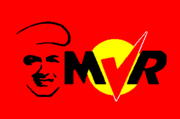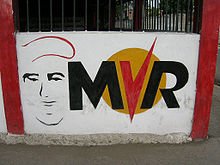- Fifth Republic Movement
-
Fifth Republic Movement
Movimiento Quinta República
Leader Hugo Chávez Founded 1997 Dissolved 2007 Headquarters Plaza Venezuela, Caracas Ideology Socialism
BolivarianismInternational affiliation Foro de São Paulo Website Official site Politics of Venezuela
Political parties
ElectionsThe Fifth Republic Movement (Spanish: Movimiento V [Quinta] República, MVR) was a left-wing, Socialist political party in Venezuela. It was founded in July 1997, following a national congress of the Revolutionary Bolivarian Movement-200, to support the candidacy of Hugo Chávez, the current President of Venezuela, in the Venezuelan presidential election, 1998. The "Fifth Republic" refers to the fact that in 1997 the then Republic of Venezuela was the fourth in Venezuelan history, and the Movement aimed to re-found the Republic through a constitutional assembly. Following Chávez' 1998 election victory, this took place in 1999, leading to the 1999 Constitution of Venezuela.
At the legislative elections on 30 July 2000, the party won 91 out of 165 seats in the National Assembly. On the same day Hugo Chávez was elected president in the presidential elections with 59.5% of votes. In the parliamentary elections of 4 December 2005, the party won 114 out of 167 seats with allied parties winning the remaining seats. Opposition parties had unexpectedly withdrawn several days before election day, and turnout was just 25%.
In December 2006 and January 2007 the party started its dissolution, to form the proposed United Socialist Party of Venezuela (PSUV). It merged into PSUV on 20 October 2007.
Contents
Foundation
The MVR was founded in July 1997 to support the electoral aims of the Revolutionary Bolivarian Movement-200. For a number of years after his 1994 release from prison, Chávez maintained a position against participation in elections, believing them a fixed game which merely legitimated the established order.[1] This led to a split with his colleague Francisco Arias Cárdenas, who left the MBR-200.[1] In the early years after his release, Chávez considered the possibility of another coup attempt, but with the prospects appearing slim, some advisers, notably Luis Miquilena, urged him to reconsider his scepticism of the elections, arguing that Chávez could potentially win so convincingly that the establishment would not be able to deny him victory.[1] To find out whether this was the case, Chávez set up teams of psychologists, sociologists, university professors and students to carry out a survey. With their support, grassroots members of the Bolivarian movement polled tens of thousands of people across the country. The results showed that 70% of respondents supported Chávez running for the presidency - and 57% said they would vote for him.[1] Support for the electoral route was strengthened when Arias Cárdenas, as a candidate for Radical Cause, won the Governorship of Zulia State in the December 1995 regional elections.[1] Despite this, the MBR-200 remained divided over electoral participation, and spent a year debating the issue in local, regional and national assemblies. A national congress on 19 April 1997 took from 9 am until 2 am the next day to reach a conclusion, ultimately deciding to launch Chávez' candidacy for the Venezuelan presidential election, 1998. Some members of the movement resigned in protest, holding too much at stake.[1] In July 1997 Chávez registered the new "Fifth Republic Movement" with the National Electoral Council (the name had to be changed as Venezuelan law did not permit parties to use Simon Bolivar's name).[1] The international media took little interest, citing opinion polls showing 8% support for Chávez.[1]
Aims
The party was committed to the Bolivarian Revolution and claimed to be the political voice of the country's poor.
Primary elections
The Movement for a Fifth Republic (MVR), former Venezuela’s governing party, was the first political party in Venezuela to incorporate primary elections as the primary method for selecting its candidates.
Led by President Hugo Chávez, but involving organizations and movements that are broader than the MVR, the question of how to select MVR candidates has been controversial. Until the implementation of this primary mechanism, candidates tended to be hand-picked by the leadership of the parties. The result has been that a number of those elected on MVR platforms were distrusted by the masses, and in some cases have proved disloyal.
The issue came to a head in the lead-up to the regional elections of October 2005. Despite opposition from within the grassroots movements, a candidate list was drawn up by the leadership of various MVR allied parties. The decision not to hold primaries was justified by the claim that there wasn't time. After the elections, Chavez stated that in the future, primaries would be held to empower the rank and file to select candidates.
Provisions introduced into the constitution and adopted by referendum in 1999 already mean that elected officials can have their mandate revoked half-way through their term if 20 % of their electors sign a petition requesting a fresh election.
A total of 2.4 million people voted in the MVR primaries. More than 5200 candidates were pre-selected to compete for the 5618 positions up for grabs in the August elections. The remaining 418 positions will go to other pro-Chavez parties. However, other pro-Chavez groups have publicly criticized the MVR for taking these positions.
The use of Venezuelan history
Venezuela historiography recognizes four "republics," or major regime changes since the country was founded in 1811. The First Republic, known as the "Venezuelan Confederation" lasted until 1812. The Second Republic is the restored republican regime that was instituted by Simón Bolívar after his Admirable Campaign in 1813, and which lasted until 1814. The Third Republic refers to the period after 1816 in which various patriot guerrilla bands joined under Bolívar's leadership in the Llanos of Venezuela and set up an independent government. This process culminated in the Congress of Angostura, but shortly thereafter the Congress declared Venezuela to be part of a larger Gran Colombia. Gran Colombia lasted only a decade and at its dissolution Venezuela became once again the "Republic of Venezuela," which is considered the start of the Fourth Republic. In 1864 the country was then restructured into the "United States of Venezuela", before reverting once again to the name, "Republic of Venezuela" in 1953. Although both periods began with the implementation of new constitutions (the fourth and twenty-fourth constitutions, respectively), both have been deemed by Venezuelan historiography as a continuation of the Fourth Republic.[2]
Since Chávez's election to the Presidency in 1999, the country has been known as the "Bolivarian Republic of Venezuela" signaling Chávez' desires to usher in a new era of politics and government. This unique "Bolivarian" government is the "Fifth Republic" referred to in the party's title. The use of the phrase also echoes the French Fifth Republic, which was another sweeping political change to deal with a large social social unrest in 1960s France.
Dissolution
On 18 December 2006, Hugo Chávez announced plans to dissolve the party, hoping that the 23 other parties that supported his government would follow suit and collectively form the proposed United Socialist Party of Venezuela. [1]
Elections the MVR participated in:
- Venezuelan presidential election, 1998, Venezuelan presidential election, 2000, Venezuelan presidential election, 2006
- Venezuelan parliamentary election, 1998, Venezuelan parliamentary election, 2000, Venezuelan parliamentary election, 2005
- Venezuelan regional elections, 1998, Venezuelan regional elections, 2000, Venezuelan regional elections, 2004
- Venezuelan constitutional referendum, April 1999, Venezuelan constitutional referendum, December 1999, Venezuelan recall referendum, 2004
Leaders of MVR
- Hugo Chávez
- Francisco Ameliach
- Juan Barreto
- Diosdado Cabello
- Jesse Chacón
- Cilia Flores
- Willian Lara
- Nicolás Maduro
- Tarek William Saab
- Luis Tascón
- Iris Varela
- Darío Vivas
References
External links
Categories:- Defunct political parties in Venezuela
- Political parties established in 1997
- Political parties disestablished in 2007
Wikimedia Foundation. 2010.

